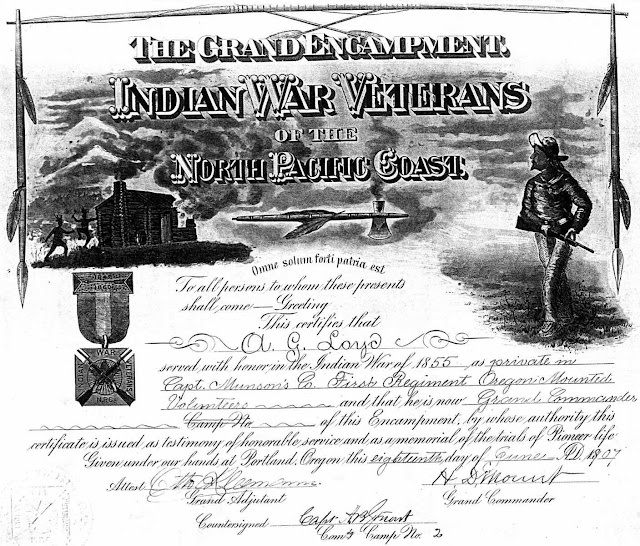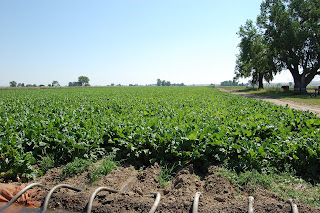My third great grandfather ( Albert Gallatin Lloyd) came west on the Oregon Trail in 1845, settling in Benton County, Oregon with his parents and siblings. Traveling through Indian country and then living with the threat of Indian activity was a fact of life.
Albert or A. G. as he was known, joined the Oregon Volunteers at the age of 19 to fight in the Indian Wars of Oregon and Washington Territory. He served in the Oregon-Washington Indian War as a corporal in Munson’s Co. "I" 1, Oregon Mtd Volunteers
It was the time of Indian conflicts in Washington and Oregon Territory. There were many reasons for the conflict, but as settlers in a new territory; the call to protect the citizens activated many. A. G.’s brother, Abner, and his father, John also joined the Oregon Volunteers. The Oregon Volunteers saw action in the Walla Walla area of the Washington Territory. In a newspaper clipping (Spokeman-Review 24 May 1908) of his 50th wedding anniversary celebration. the details of his service in the Indian War were given. He was involved in a 4 days battle on the Walla Walla River, December 7-10 of 1855.
Index to Indian Wars Application Pension Files, 1817-1926, digital images, Fold3
(https://www.fold3.com/image/624161137?terms=Albert%20g%20Lloyd : viewed 9 October 2019) Citing the pension application for Albert G. Lloyd, National Archives and Records Administration (NARA), Microfilm publication T318, Record Group 5, roll 7;
Albert G. Lloyd Indian War Veterans Certificate, Lloyd Family collection; privately held by Sydney Gabel [address for private use] Huntley, Montana 2019
Returning from the Indian Wars to the Williamette Valley and Benton County, Oregon, he married Lois Jasper on 20 May 1858. Lois was 16 and A. G. was 21. Their first son, John Calvin, was born in May of 1859. That summer Lois and A. G. moved to the Walla Walla Valley, near Waitsburg, and took up a homestead. In the area that he had seen during the Indian Wars. He brought with him about 180 head of cattle, trailing them from the WilliametteValley and over the Cascade mountains.
His story is not unusual for the times. But what is unusual is how he lived among the Indians after settling on his homestead. A. G. had made a pact with Big Thunder, a leader of the Palouse Indians, that they could continue to use their traditional campsite on the Touchet River near Waitsburg. Friendship was totally out of context for an Indian War veteran.
In a native American culture, gifting is a way of respect. The Indians and the Lloyd’s often exchanged gifts; the Lloyd’s offered food (mostly meat and produce) and the Indians gave the Lloyd’s cultural items such as purses, headdresses, moccasins, baskets and clothing.
Wesley Lloyd, his son, collected the items and maintained the collection. The collection was gifted to the Fort Walla Walla Museum. There is a permanent display of items from the collection. The majority of the items were on a 2 year display. I went to the grand opening of the exhibit in 2007 and it was quite wonderful to see the items. But the biggest suprirse I received was when the Indians from the area, came and thanked me for the generosity of the Lloyd family. Stories about the generosity of the Lloyd family has been passed down in the Indian culture for over 100 years.
I am honored to be a part of that legacy.
Lois & Albert Gallatin Lloyd
If you are ever near Walla Walla, Washington be sure and stop and tour the Lloyd exhibit.
The Lloyd Exhibit is at Fort Walla Walla Museum: https://www.fwwm.org/lloyd-family
Fort Walla Walla Museum
755 Myra Road
Walla Walla, Washington 99362































